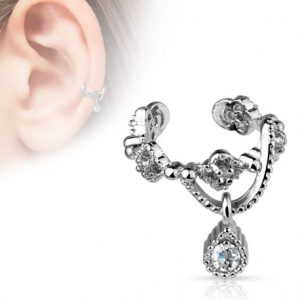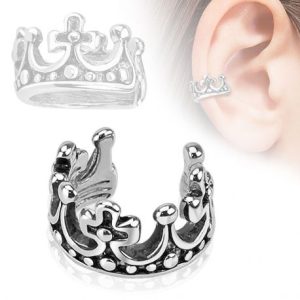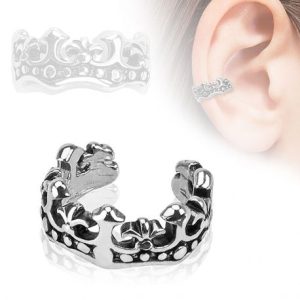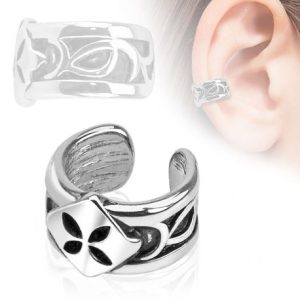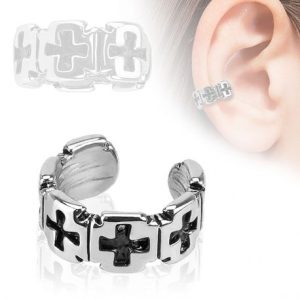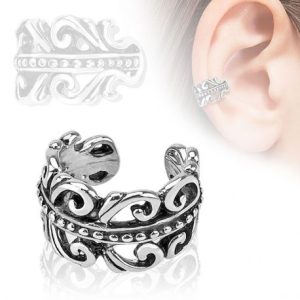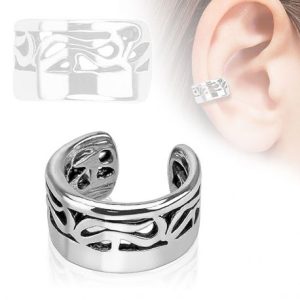Fake Ear Piercing
Fake Ear Piercings: The Ultimate Guide
If you’ve always wanted to try an ear piercing without making a commitment, fake ear piercings may be your answer. These temporary piercings come in different styles, colors and materials, allowing you to experiment with different looks without the pain, healing time and permanent changes of a real piercing. In this article, we’ll cover everything you need to know about fake ear piercings, from types and benefits to application and maintenance.
What are fake ear piercings?
Fake ear piercings are accessories that mimic the look of real ear piercings without actually puncturing the earlobe or cartilage. They can be worn by people who don’t want to commit to a real piercing or are unable to get one due to personal, cultural, or medical reasons. Fake ear piercings are often used as fashion statements, costume accessories, or temporary substitutes for lost or closed piercings. They can be made of various materials, such as metal, plastic, silicone, or fabric, and designed in various shapes, sizes, and colors.
Types of fake ear piercings
There are several types of fake ear piercings available in the market, each with its own advantages and disadvantages. Here are some of the most common ones:
-
Clip-on earrings
These are the classic fake earrings that have been around for decades. Clip-on earrings are the classic type of fake ear piercings that use a metal or plastic clip to attach to the earlobe. They come in various styles, such as studs, hoops, dangles, and cuffs, and can be adjusted to fit different ear sizes and shapes. Clip-on earrings are easy to wear and remove, but they may feel tight or uncomfortable after prolonged use. They may also leave a mark or pinch the skin if worn too tightly or for too long.
-
Magnetic earrings
Magnetic earrings use a magnet to secure the earring to the earlobe, without the need for a clip or backing. They consist of two small magnets—one on the front and one on the back of your earlobe—which hold the earring in place. They are usually made of metal or plastic, and can be found in different designs and strengths. Magnetic earrings are more comfortable than clip-on earrings, as they don’t pinch the skin or leave a mark. However, they may not be suitable for people with pacemakers or other medical devices that can be affected by magnets.
-
Stick-on earrings
Stick-on earrings are adhesive stickers that can be applied to the earlobe or cartilage, creating the illusion of a piercing. They are usually made of paper, plastic, or silicone, and come in various shapes, sizes, and colors. Stick-on earrings are easy to apply and remove, and can be reused multiple times. However, they may not stick well on oily or sweaty skin, and may cause irritation or allergies if not hypoallergenic.
-
Fake plugs and tapers
Fake plugs and tapers are ear jewelry that mimics the look of stretched earlobes or cartilage, without actually stretching them. They are usually made of metal or acrylic, and come in different gauges and styles. Fake plugs and tapers can be worn by people who don’t want to stretch their ears, but still want to achieve the edgy or alternative look. However, they may not fit well on small or irregularly shaped ears, and may require some adjustment to wear comfortably.
-
Fake ear cuffs and climbers
Fake cuffs and climbers are ear jewelry that wraps around the earlobe or cartilage, creating the illusion of multiple piercings or a unique style. They are usually made of metal or plastic, and come in various shapes and designs, such as chains, spirals, and vines. Fake cuffs and climbers are easy to wear and remove, and can be adjusted to fit different ear shapes and sizes. However, they may not stay in place if the ear is too small or too curved, and may cause discomfort or irritation if worn too tightly or for too long.
Benefits of fake ear piercings
Fake ear piercings offer several benefits for those who want to try out a new look without committing to a real piercing. Here are some of the advantages of fake ear piercings:
- No pain or healing time: Fake ear piercings don’t require any needles or piercing guns, and can be applied and removed quickly and easily.
- No permanent changes: Fake ear piercings can be removed whenever you want, without leaving a scar or mark on your ear.
- Versatility: Fake ear piercings come in various styles, shapes, and colors, allowing you to switch up your look without investing in multiple piercings.
- Affordability: Fake ear piercings are usually less expensive than real piercings, making them a budget-friendly option for fashion experimentation.
- Accessibility: Fake ear piercings can be worn by people who are unable or unwilling to get a real piercing due to personal, cultural, or medical reasons.
How to apply fake ear piercings?
Applying fake ear piercings depends on the type of piercing you choose. Here are some general tips for applying fake ear piercings:
- Clean your ear with alcohol or soap and water before applying the piercing, to prevent infection or irritation.
- Choose a piercing that fits your ear size and shape, and matches your outfit or mood.
- Follow the instructions that come with the piercing, whether it requires clipping, sticking, or wrapping around your ear.
- Adjust the piercing gently, to avoid pinching or pulling your skin or hair.
- Check the piercing periodically, to make sure it hasn’t fallen off or caused any discomfort or allergic reactions.
Tips for wearing and maintaining fake ear piercings
To make the most of your fake ear piercings, here are some tips for wearing and maintaining them:
- Coordinate your piercings with your outfit or jewelry, to create a cohesive look.
- Experiment with different types and styles of piercings, to find your favorite combinations.
- Avoid wearing your piercings while swimming, showering, or sleeping, to prevent damage or loss.
- Store your piercings in a clean and dry place, to prevent dirt or bacteria buildup.
- Clean your piercings with a mild soap and water, and dry them thoroughly before wearing them again.
- Replace your piercings regularly, especially if they show signs of wear or tear, or if you’ve had them for a long time.
Frequently asked questions about fake ear piercings
Are fake ear piercings safe?
Yes, as long as you follow the instructions and choose a piercing that is hypoallergenic and fits your ear properly.
How long do fake ear piercings last?
It depends on the type and quality of the piercing, as well as how often you wear and maintain it. Some piercings can last for months or even years, while others may need to be replaced after a few uses.
Can fake ear piercings cause allergies?
Yes, if the piercing is made of a material that your skin is allergic to, or if you apply it on unclean or sensitive skin. To avoid allergies, choose a piercing that is hypoallergenic and clean your skin before applying it.
Can I wear fake ear piercings if I have real piercings?
Yes, you can wear fake ear piercings alongside real piercings, to create a layered or embellished look.
How do I remove fake ear piercings?
The removal process depends on the type of piercing. Clip-on earrings can be unclipped, magnetic earrings can be pulled apart, stick-on earrings can be peeled off, and fake plugs, tapers, cuffs, and climbers can be unwrapped or slid off gently.

